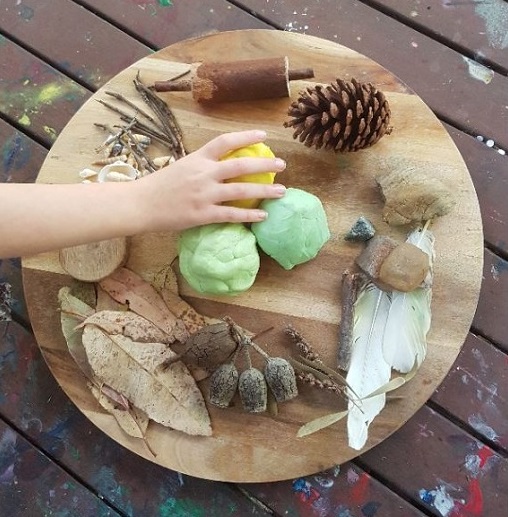2.4 Play conflict and the role of the adult
Sometimes our different ideas about play and our different ways of communicating with each other can bring children (and adults) into conflict. The final activity in this section encourages you to think about the role of the adult in supporting children’s relationships and interactions.
Activity 2.4 Accessibility and play
Play conflict scenario
ELC practitioner Ania has created an accessible space for playing with play dough.
A table is available where children can sit or stand to use the dough. The dough, made by the children with Ania’s help, has been coloured green to create a colour contrast with the beige working table. Rosewater has been added to add an interesting smell. Ania has placed a selection of rolling and cutting tools on the table, along with small items such as shells, string and twigs and pinecones.

Ahmed and Sammie are playing with all the dough and building what looks like a nest. Nina approaches the table. Nina takes some shells and twigs out of the basket and arranges them. Every now and then Nina stares at the children with the play dough. Suddenly Nina snatches some of the dough away from the two children playing together and throws it on the floor. Ania intervenes and tells the third child that they are not allowed to snatch and asks them to play elsewhere.
Ania has taken time to think about the accessibility of this play resource. It is multi-sensory and offers open-ended play; the resources she has included indicate that play dough does not need to be rolled and cut in imitation of cooking. However, within a few minutes a child has been excluded from using the space. How could Ania ensure a more inclusive experience?
Make a few notes on Ania’s role in:
- observing how the space is used
- supporting conflict resolution
- helping children to pursue their play needs.
What would you do differently?
Discussion
The play dough is a limited resource that needs to be shared and looked after. Children may need to be supported in how they make use of it. This is not about enforcing ‘play dough rules’, but about discussing how to share and care for the play resource together. Sometimes our attachment to a resource might mean emotions run high – for adults too. It can help to remind ourselves, as well as children, to take a moment to think before we speak or act.
Some practical tips that Ania might consider doing:
- Talk to the children about how it might be fair to leave some play dough unused so other friends could join in.
- Observe interactions at the table. The two children playing together did not interpret the third child staring at them as a request for play dough or to join in the play. This might be a subtle play cue. Adults can give words to a child who is not vocal. You might say: ‘I can see that you are looking at the play dough. Would you like to play with it?’ You can then model a way of asking to play: ‘You could ask Ahmed and Sammie to share some with you. Ahmed, Sammie, can you see that Nina would like to play?’
- Be ready to support the children. Perhaps Nina is often impulsive or physical in her response to situations? Perhaps Nina is not able to express herself clearly using words or gestures, and becomes frustrated? Ania could welcome Nina and talk to her about the play dough and discuss what the other children are doing.
- Help the children to get back to their play. If Ania missed these earlier opportunities to intervene she could explain that it is not OK to snatch the play dough and could model how to ask to share or how to use the play dough in this space. That way a child is not excluded from play because they lacked support to gain access to the play.
- Be curious about Nina’s play needs. What is Nina communicating with her actions? Ania needs to find out what is most important to Nina. Is it finding a way to play with others? Is it gaining adult attention? Is it a need for whole body physical play that is met by throwing the play dough? This is not easy to answer from a single observation but is the kind of understanding that can be built up over time.
While Ania might find a way to ensure this play resource is inclusive, it is important to consider it in context of the whole nursery. Play dough is an indoor activity, often at a table. It can involve whole body movements as well as fine motor skills. Compare it to an activity like playing with mud outside. Does the nursery environment welcome large body movements and messy engagement with materials? Perhaps this is what Nina is looking for?
You may have wondered why this scenario did not state whether any of the children have ASN. This type of interaction is quite common for children of any age and stage, and may result from a range of reasons. You may not always have the knowledge and understanding of a child’s background or disability, but because you need to support each unique child you need to be prepared to observe, learn and intervene sensitively.
Playing outside
